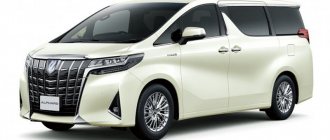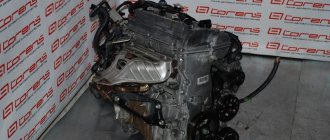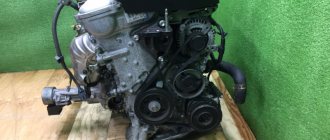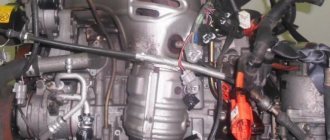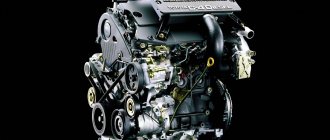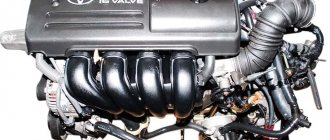- Engines
- Toyota
- 3ZR-FAE
The 2.0-liter Toyota 3ZR-FAE engine has been assembled since 2008 at factories in Japan and the USA and is installed on front-wheel drive models like Avensis and all-wheel drive crossovers like RAV4. The engine is equipped with two variable valve timing systems: Valvematic and Dual VVT-i.
- Characteristics
- Consumption
- Application
- Breakdowns
Technical characteristics of the Toyota 3ZR-FAE 2.0 liter engine
| Exact volume | 1987 cm³ |
| Supply system | MPI injector |
| Engine power | 148 – 158 hp |
| Torque | 190 – 200 Nm |
| Cylinder block | aluminum R4 |
| Block head | aluminum 16v |
| Cylinder diameter | 80.5 mm |
| Piston stroke | 97.6 mm |
| Compression ratio | 10 – 10.5 |
| Features of internal combustion engines | Valvematic |
| Hydraulic compensators | Yes |
| Timing drive | chain |
| Phase regulator | Dual VVT-i |
| Turbocharging | No |
| What kind of oil to pour | 4.2 liters 5W-20 |
| Fuel type | gasoline AI-95 |
| Environmental class | EURO 4/5 |
| Approximate resource | 250,000 km |
Fuel consumption
The Japanese-made power unit is distinguished by moderate fuel consumption.
If we take into account the performance of the Toyota RAV4 with an all-wheel drive platform and a variable transmission, then gasoline consumption in different driving modes is as follows:
- Operation in the urban cycle - 9.4 l/100 km.
- Driving on the highway - 6.4 l/100 km.
- Mixed driving mode – 7.5 l/100 km.
The 3ZR-FA engine, which is used in the Toyota Avensis, with identical volume and variable transmission, produces the following indicators:
- Urban mode - 9.2 l/100 km.
- Highway – 5.7 l/100 km.
- Combined cycle - 7.7 l/100 km.
Among the advantages of the engine are its efficiency. At the same time, the exact fuel consumption directly depends on the weight of the car and driving style.
Toyota RAV4 uses 6.4 liters of fuel per 100 km.
Disadvantages, breakdowns and problems of Toyota 3ZR-FAE
Most often on forums, drivers complain about extraneous noises and knocks during operation.
In second place are stories about how much oil this engine consumes per 1000 km.
The water pump often breaks down at 50,000 km, and after 150,000 km the chain is pulled out
The intake manifold quickly becomes overgrown with coke, which leads to floating speed
The Valvematic system causes a lot of problems; the control unit regularly malfunctions
You can contact the site administrator by email: [email protected]
All texts were written by me, are authored by Google, included in the original Yandex texts and notarized. For any borrowing, we immediately write an official letter on company letterhead in support of search networks, your hosting and domain registrar.
Next we go to court. Don’t try your luck, we have more than thirty successful Internet projects and have already won a dozen lawsuits.
3ZR engines are four-cylinder engines with a 16-valve gas distribution mechanism. The production of internal combustion engines (ICE) of this series began in 2007 and continues at Toyota enterprises to this day. Below we will talk about the technical characteristics, shortcomings and problem units, modifications and options for improving the 3ZR-FE unit.
Characteristics of 3ZR
The technical characteristics of the 3ZR engine are largely determined by two systems:
1) Dual VVT-i gas distribution, represented by two camshafts (one for the intake valves, the other for the exhaust valves);
2) control of the composition of the Valvematic fuel-air mixture (FAE) (on the 3ZR modification - FAE).
The 3ZR engine is equipped with a one-piece block with four cylinders, each of which has four valves (two intake and two exhaust). DOHC circuit is used. The block material is aluminum. The sleeves are made of cast iron.
Additional improvements
Toyota is the first automobile company to use the Valvematic system on its cars. 3ZR-FAE Valvematic is a system for smoothly changing valve lift height. One of the cars that was equipped with this system was the Toyota Avensis released in 2009. In addition, some details have been improved on the new ZR engine series, which has improved overall performance. Improvements were made: hydraulic compensators and crankshaft desaxing. Owners of cars of the Corolla family could experience these improvements, because this particular modification of the engine was installed on these cars. Later they began to be installed on models of classes “B”, “C” and “D”, as well as on minivans and SUVs based on them, for example on the Toyota Isis and RAV4.
Disadvantages and weaknesses of 3ZR
The disadvantages of the 3ZR engines were inherited from the ZZ series power units. These include: increased oil consumption, noise, pump leakage, vibrations at idle, and relatively low service life.
The problems that most often make themselves felt to car owners are presented below:
1) the inability to carry out major repairs of the internal combustion engine;
2) stretching of the timing chain, leading to increased noise (eliminates by replacing the part);
3) strong vibration at idle, which cannot be eliminated by replacing the pillows (a design feature of 3zr engines);
4) poor starting when cold and knocking in the timing belt (it is necessary to monitor the quality of the fuel and change filters on time);
5) failures in operation during start (the problem can be corrected by resetting the control unit);
6) rapid clogging of fuel filters when using low quality fuel;
7) breakdown of hydraulic compensators when using poor quality oil;
 rapid failure of valve seals (only regular replacement helps).
rapid failure of valve seals (only regular replacement helps).
It is possible to increase the resource of the power unit only through the use of high-quality oil, regular oil changes and moderate loads.
Engine design
The 3ZR-FE series engines have a light alloy block, which is equipped with an open cooling circuit. The sleeves are integrated into the aluminum surface, and their outer part has a characteristic unevenness. This ensures reliable fixation of the elements and has a positive effect on heat dissipation. Between the cylinders there is a wall 7 mm thick.
The crankshaft is equipped with 8 counterweights with journals of reduced width, which reduces losses. A large cast crankcase is fixed to the block, which is used as an oil pan.
The pistons are made of light alloys and have a T-shaped configuration.
The engine has a vertical arrangement in the engine compartment, which simplifies its maintenance or repair in case of failure.
3ZR-FE engine in the engine compartment.
3ZR variants
The 3ZR engine has three modifications - 3ZR-FE, 3ZR-FAE and 3ZR-FBE. The main modification is the first on the list. The internal combustion engine of Toyota cars, equipped with two camshafts for intake and exhaust valves, produces 143 hp. The FAE engine is improved with the Valvematic system. Its peculiarity is that the control unit, depending on the driving mode, gives a signal to change the stroke length of the intake valves. The system also selects the optimal fuel assembly composition. The power here is higher and is already 155 hp. Otherwise, the differences in technical characteristics are minor. FBE engines are designed to run on biofuel and are capable of producing 151 hp. This modification is found on Brazilian Toyota Corolla cars.
It's time to consider the design features of the next generation of Toyota engines, starting with the most common ZR series.
Application
The ZR series engines made their debut in the fall of 2006 on the domestic market, as part of a large-scale update of the Corolla and Premio families; in the summer of 2007, serial production of the first engines with Valvematic began. New engines quickly took the place of their predecessors in the line: 3ZZ-FE ⇒ 1ZR-FE/FAE, 1ZZ-FE ⇒ 2ZR-FE/FAE, 1AZ-FE/FSE ⇒ 3ZR-FE/FAE. In the early 2010s, they were installed on a wide variety of models of classes B (Yaris), C (Corolla family), D (Premio family), mid-size SUVs (RAV4) and vans (Noah).
Characteristics
| Engine | Working volume, cm3 | Bore x Stroke, mm | Compression ratio | Power, hp | Torque, Nm | RON | Weight, kg | Market/Standard |
| 1ZR-FE | 1598 | 80.5 x 75.5 | 10.2 | 124 / 6000 | 157 / 5200 | 95 | 116 | EEC |
| 1ZR-FAE | 1598 | 80.5 x 75.5 | 10.2 | 132 / 6400 | 160 / 4400 | 95 | 122 | EEC |
| 2ZR-FE | 1798 | 80.5 x 88.3 | 10.0 | 136 / 6000 | 175 / 4400 | 91 | 117 | EEC |
| 2ZR-FE | 1798 | 80.5 x 88.3 | 10.0 | 125-136 / 6000 | 163-175 / 4400 | 91 | 117 | JIS |
| 2ZR-FAE | 1798 | 80.5 x 88.3 | 10.0 | 147 / 6400 | 180 / 4000 | 95 | 123 | EEC |
| 2ZR-FAE | 1798 | 80.5 x 88.3 | 10.0 | 130-144 / 6400 | 161-176 / 4400 | 91 | 123 | JIS |
| 3ZR-FE | 1987 | 80.5 x 97.6 | 10.0 | 139 / 6500 | 189 / 4400 | 91 | 116 | EEC |
| 3ZR-FE | 1987 | 80.5 x 97.6 | 10.0 | 143 / 5600 | 194 / 3900 | 91 | 116 | JIS |
| 3ZR-FAE | 1987 | 80.5 x 97.6 | 10.0 | 152-158 / 6200 | 192-196 / 4400 | 91 | — | JIS |
| 4ZR-FE* | 1598 | 80.5 x 78.5 | 10.2 | 118 / 6000 | 150 / 4400 | 91 | — | CHI |
* - internal designation of the Chinese-made 1ZR-FE engine for the Chinese market.
In comparison with modern analogues from other manufacturers, the performance of the 1.6 and 1.8 vm engines looks good, but the 2.0 and 2.0 vm do not stand out from the crowd. As for the efficiency of cars with such engines, it can be assessed from acceptable to good (in the conventional category “10 liters”); characterized by low consumption at cruising speeds on the highway and a noticeable dependence on the temperature outside. Although a significant role is played by the combination of new engines with CVTs that are more efficient in this regard, since when paired with classic hydromechanical automatic transmissions, the ZRs show, at best, “average” efficiency.
Cylinder block
— The engine uses an aluminum (light alloy) lined cylinder block with an open cooling jacket. — The sleeves are fused into the block material, and their special uneven outer surface contributes to the most durable connection and improved heat dissipation. The wall thickness between the cylinders is only 7 mm; the manufacturer does not provide for major engine overhauls by definition. And although circumstances sometimes force enthusiasts to carry out boring or re-sleeving of disposable Toyota blocks, the final result of such “collective farming” can no longer be called “Toyota”.
— The crankshaft is installed with an 8-mm degassing (the cylinder axes do not intersect with the longitudinal axis of the crankshaft, due to which the loads in the piston-liner pair are reduced at the moment of creation of maximum pressure in the cylinder). This solution was already used on the AZ and NZ engines, but was not available on the ZZ.
— The crankshaft has 8 counterweights on the cheeks, journals of reduced width (for the sake of reducing losses, even at the cost of durability) and traditional separate main bearing caps (Toyota abandoned the single crankshaft support used on the ZZ series). — A massive cast crankcase is attached to the block, acting as the upper part of the oil pan. — The compact steel lower oil pan can be removed without removing other structural components.
— Pistons are light-alloy, compact T-shaped, with a rudimentary skirt. The groove of the upper compression ring has an anodized coating, the edges of the upper compression and oil scraper rings have an anti-wear coating using the vapor condensation method. The pistons are connected to the connecting rods using completely floating pins. — The engine is placed vertically under the hood (without tilting towards the engine shield), without complicating maintenance. — The power unit is mounted on four supports, the upper right one of which is “oil-filled.” — All engines have the same cylinder diameter and differ in piston strokes. And if the 1.8 engine turned out to be simply long-stroke, then the 2.0 is close to the record. As a result, the average piston speed in rated power mode is about 22 m/s, which was once considered beyond the upper limit for sports engines. Even despite the lightweight pistons and the notorious new technologies, this is not good in terms of durability for a purely civilian engine. And some of the problems with oil waste are also directly related to the above figure. — Unlike engines of previous series, camshafts are now installed in a separate housing, which is then mounted on the cylinder head — this has somewhat simplified the design and processing technology of the cylinder head itself.
Cylinder head
— Instead of adjusting pushers (“cups”), hydraulic valve lash compensators and roller pushers/rockers are widely used.
— The camber angle of the intake and exhaust valves is 29°, which by Toyota standards is not so small. — The light-alloy head cover received an oil supply line to the rockers. — On Valvematic engines, a vane vacuum pump is driven from the rear of the exhaust camshaft, which is necessary to operate the brake booster.
Timing drive
— The gas distribution mechanism is driven by a single-row fine-pitch chain (8 mm). The hydraulic chain tensioner has a locking mechanism, is easily removable and is installed on the outside of the cover.
— The design of the cast aluminum timing chain cover has become more complex - a cooling system pump and an oil line for the chain lubrication nozzle are installed in it.
— Variable valve timing drives are installed on the camshafts of both intake and exhaust valves (DVVT - Dual Variable Valve Timing). The phases vary within 55° for intake and 40° for exhaust. — Each of the ZR engines received a modification with a system of continuously variable intake valve lift (Valvematic), a description of the capabilities and operation of which should be given in a separate article - see “Valvematic System”.
— Experience shows that for Toyota engines, critical stretching of the chain and, accordingly, the need to replace it occurs after a mileage of about 150 thousand km. Although there is a nuance here - when replacing the chain, other elements of the timing drive (sprockets, tensioner shoe, guide) should also be changed, since sprockets already affected by wear quickly “eat up” the new chain. Unfortunately, the sprockets of Toyota camshafts are combined with low-cost VVT drives and cannot be changed separately, so the real effect of simply installing a new chain is insufficient. — A trochoid-type gear oil pump is installed in the crankcase and is driven from the crankshaft by a separate short chain (similar to AZ engines). This significantly improves the performance of the system when starting in winter conditions, but complicates the design. — On newer engines with Valvematic, an oil pump with a mechanical bypass valve is installed, which allows non-linear adjustment of oil flow/pressure depending on the crankshaft speed.
— The block contains oil nozzles for cooling and lubrication of the pistons.
— The oil filter is installed inconveniently, on the rear side of the engine and horizontally - unlike previous series, where the filter was located vertically with the holes up, which in itself did not allow oil to drain from the filter into the sump when parked and contributed to the rapid creation of pressure after starting. Since 2008, “economical” collapsible filters with replaceable cartridges began to be used.
Cooling
— The cooling system is implemented without newfangled solutions, such as an electric pump drive or a heated thermostat - the pump rotates from the outside of the common drive belt for mounted units, the thermostat is mechanical, the throttle body is still heated by liquid to counteract freezing.
— But the radiator fan of Valvematic engines now has a separate electric motor control unit, which allows you to continuously adjust its speed depending on the coolant temperature, air conditioning refrigerant pressure, vehicle speed and crankshaft speed.
Inlet and outlet
— As on the ZZ series, a plastic intake manifold is installed at the front, a steel exhaust manifold is installed on the side of the engine shield. Behind the manifold in the exhaust tract there is a preliminary catalyst, a little further there is a second catalyst combined with the main muffler. — Engines with Valvematic received an intake manifold with an ACIS system that changes the effective length of the intake tract to increase power. At low and medium speeds and high loads, the ACIS valve is closed and air flows through a long path; in other ranges, the valve is open and air flows through a shorter path.
Control system
— Fuel injection is traditional distributed, under normal conditions it is sequential; at low temperatures and low rotation speeds, group and pairwise injection can be used. — Mass air flow (MAF) sensor of the “hot wire” type, combined with an intake air temperature sensor. - Throttle valve - fully electronically controlled (ETCS): DC motor driven, non-contact two-channel Hall effect position sensor. ETCS performs the functions of idle speed control (ISC), traction control (TRC), part of the functions of the stability control (VSC) and cruise control.
— Accelerator pedal position sensor — non-contact two-channel, Hall effect. — Camshaft position sensors are magnetoresistive, unlike previous inductive ones, they provide a digital signal at the output and work properly at low speeds. — The knock sensor is a flat, broadband piezoelectric; unlike older resonant-type sensors, it registers a wider range of vibration frequencies. — On the 1ZR-FE engine, a conventional planar-type oxygen sensor (89465-) can be used (the advantage over the traditional cap type is rapid warm-up due to an effective heater); on other engines, a mixture composition sensor (AFS) (89467-) is installed. The sensor behind the catalyst is a regular oxygen sensor, cap type, on all models. — Injectors with an extended nozzle are installed in the cylinder head and inject fuel as close as possible to the intake valves. This makes a negligible contribution to the “environmental friendliness”, however, at significant negative temperatures, gasoline sometimes simply does not have time to evaporate sufficiently. - Fuel line - without return line, a pressure pulsation damper is built into the fuel manifold. In addition to the pressure regulator and level sensor, the fuel vapor recovery system (EVAP) adsorber is also integrated into one unit with the fuel pump in the tank. — Ignition system — traditional DIS-4 (separate ignition coil for each cylinder). Spark plugs - thin “iridium” SC20HR11 with an extended threaded part, turnkey “14” - made it possible to further increase the size of the valve plates.
— The charging system uses two types of generators - conventional and with a segmented conductor, with an output of 90-100 A and an overrunning clutch in the drive pulley. — On engines with Valvematic, the battery is continuously charged as the vehicle slows down, and in steady-state driving conditions, battery charging and discharging cycles alternate for maximum efficiency. More complex control required the use of a battery temperature sensor and a current sensor in the system. — The starting system is traditional, the starters are with a planetary gearbox, with a power of 0.8-1.1 kW. — The drive of attached units is a single belt, without a separate tensioner (tension adjustment is by moving the generator). After the well-known ZZ problems with oil consumption, the approach to the new generation was cautious from the very beginning, and not in vain - the phenomenon of oil waste on almost new engines (2..3 years of operation) appeared again. Toyota has not yet caught up with their German colleagues with their permissible consumption of “liter per thousand”, however, 200-300 ml per 1000 km is no longer considered critical. Although, if in the case of ZZ, oil waste clearly indicated mechanical problems (at least about the occurrence of rings), then in ZR the reason often turns out to be the use of extremely liquid energy-saving oil of the 0W-20 class recommended by the Japanese, so switching to more adequate viscosities can solve the problem . The manufacturer himself mentioned oil consumption back in the 2008 service bulletins (although an unexpected solution was proposed there - recalibration of the engine control unit). The bulletins also trace several other possible problems of the ZR series - difficult starting and misfires due to increased carbon formation in the combustion chambers (2009), traditional EVAP errors (2009-2011), replacement of camshaft sprockets due to knocking in the VVT mechanism (2009) , replacement of the coolant pump due to leaks and noise (2009-2010), problems with forced idling (2011), problems with hot start (2011), replacement of the generator due to a defective pulley (2009-2010)… For modern engines, no destructive breakdowns during the warranty period, a normal winter start and a reasonable appetite can already be considered an achievement. By these criteria, the ZR series is still considered acceptable - at least not worse than the ZZ and AZ (especially since the ZR with Valvematic has just replaced the AZ versions with dubious D-4 direct injection). However, statistically significant conclusions can be drawn only in a few years, when the mileage of a more significant part of cars with these engines approaches one and a half hundred thousand, a landmark for today’s Toyotas.
Eugene
Moscow [email protected]
© Legion-Avtodata
Tuning
Increasing pumping power, reducing resistance and improving cylinder purging (together atmospheric tuning) do not provide significant changes in the operation of the 3ZR series engine.
Noticeable changes in performance can be achieved by flashing the electronic control unit (ECU), modifying the cylinder head (expanding the channels due to boring), and replacing injectors with more efficient ones. This procedure is called porting or porting. The result will be an increase in engine power by 15-20 hp.
Installing an SC 14 compressor in combination with injectors from the 2ZZ-GE engine allows you to increase power to 180 hp. Fans of upgrading the 3zr engine prefer this option.
Using a Garret GT28 turbine in combination with replacing the injectors, ECU, fuel pump and exhaust system will help extract up to 300 hp from the internal combustion engine. But such high power indicators will certainly have a detrimental effect on the resource of the unit, which already does not shine with longevity.


